Hollywood, Los Angeles: Difference between revisions
| [pending revision] | [pending revision] |
m Reverted edits by 208.122.80.126 (talk) to last revision by ClueBot NG (HG) |
|||
| Line 75: | Line 75: | ||
In 1985, the [[Hollywood Boulevard|Hollywood Boulevard Commercial and Entertainment District]] was listed in the [[National Register of Historic Places]]. |
In 1985, the [[Hollywood Boulevard|Hollywood Boulevard Commercial and Entertainment District]] was listed in the [[National Register of Historic Places]]. |
||
In June 1999, the Hollywood extension of the [[Los Angeles County Metro Rail]] [[LACMTA Red Line|Red Line]] [[rapid transit|subway]] opened from [[Downtown Los Angeles]] to the San Fernando Valley, with stops along |
In June 1999, the Hollywood extension of the [[Los Angeles County Metro Rail]] [[LACMTA Red Line|Red Line]] [[rapid transit|subway]] opened from [[Downtown Los Angeles]] to the San Fernando Valley, with stops along Hd Boulevard at Western Avenue, Vine Street and Highland Avenue. |
||
[[File:HollywoodKodak.JPG|thumb|The Dolby Theatre]] |
[[File:HollywoodKodak.JPG|thumb|The Dolby Theatre]] |
||
Revision as of 09:03, 30 April 2014
Hollywood | |
|---|---|
 The Four Ladies installation at the Hollywood-La Brea Gateway |
Hollywood /ˈhɒliwʊd/ is a district in the central region of Los Angeles, California, in the United States.
It is notable for its place as the home of the entertainment industry, including several of its historic studios. Its name has come to represent the motion picture industry of the United States. Hollywood is also a highly ethnically diverse, densely populated, economically diverse neighborhood and retail business district.
Hollywood was a small community in 1870 and was incorporated as a municipality in 1903.[1][2] It merged with the City of Los Angeles in 1910, and soon thereafter a film industry began to emerge, eventually becoming dominant in the world.[3][4]
History
In 1853, one adobe hut stood in Nopalera (Nopal field), named for the Mexican Nopal cactus indigenous to the area. By 1870, an agricultural community flourished. The area was known as the Cahuenga Valley, after the pass in the Santa Monica Mountains immediately to the north.
The name Hollywood was coined by H. J. Whitley, the "Father of Hollywood".[5] Whitley arranged to buy the 500-acre (2.0 km2) E.C. Hurd ranch and disclosed to him his plans for the land. They agreed on a price and Hurd agreed to sell at a later date. Before Whitley got off the ground with Hollywood, plans for the new town had spread to General Harrison Gray Otis, Hurd's wife, Mrs. Daeida Wilcox and others.
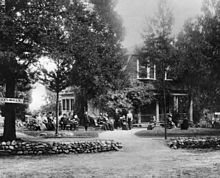
Daeida learned of the name Hollywood from Ivar Weid, her neighbor in Holly Canyon (now Lake Hollywood) and a prominent investor and friend of Whitley's.[6][7] She recommended the same name to her husband, Harvey. H. Wilcox. On February 1, 1887, Harvey filed a deed and map of property he sold with the Los Angeles County Recorder's office. Harvey wanted to be the first to record it on a deed. The early real-estate boom busted that same year, yet Hollywood began its slow growth.
By 1900, the region had a post office, newspaper, hotel, and two markets. Los Angeles, with a population of 102,479[8] lay 10 miles (16 km) east through the vineyards, barley fields, and citrus groves. A single-track streetcar line ran down the middle of Prospect Avenue from it, but service was infrequent and the trip took two hours. The old citrus fruit-packing house was converted into a livery stable, improving transportation for the inhabitants of Hollywood.

The Hollywood Hotel was opened in 1902 by H. J. Whitley, president of the Los Pacific Boulevard and Development Company. Having finally acquired the Hurd ranch and subdivided it, Whitley built the hotel to attract land buyers. Flanking the west side of Highland Avenue, the structure fronted on Prospect Avenue, which, still a dusty, unpaved road, was regularly graded and graveled. The hotel was to become internationally known and was the center of the civic and social life and home of the stars for many years.[9]
Whitley's company developed and sold one of the early residential areas, the Ocean View Tract.[10] Whitley did much to promote the area. He paid thousands of dollars for electric lighting, including bringing electricity and building a bank, as well as a road into the Cahuenga Pass. The lighting ran for several blocks down Prospect Avenue. Whitley's land was centered on Highland Avenue.[11][12]
Incorporation and merger

Hollywood was incorporated as a municipality on November 14, 1903, by a vote of 88 for and 77 against. On January 30, 1904, the voters in Hollywood decided, by a vote of 113 to 96, for the banishment of liquor in the city, except when it was being sold for medicinal purposes. Neither hotels nor restaurants were allowed to serve wine or liquor before or after meals.
In 1910, the city voted for merger with Los Angeles in order to secure an adequate water supply and to gain access to the L.A. sewer system. With annexation, the name of Prospect Avenue was changed to Hollywood Boulevard and all the street numbers in the new district changed.[13]
Motion picture industry
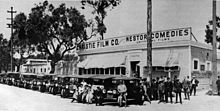
By 1912, major motion-picture companies had set up production near or in Los Angeles.[14]
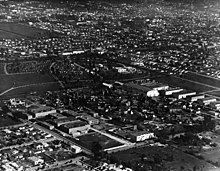
Director D. W. Griffith was the first to make a motion picture in Hollywood. His 17-minute short film In Old California, was filmed for the Biograph Company.[15][16][17] Although Hollywood banned movie theaters—of which it had none—before annexation that year, Los Angeles had no such restriction.[18] The first film by a Hollywood Studio, Nestor Motion Picture Company, was shot on October 26, 1911.[19] The Whitley home was used as its set, and the unnamed movie was filmed in the middle of their groves on the corner of Whitley Avenue and Hollywood Boulevard.[20]
The first studio in Hollywood, the Nestor Company, was established by the New Jersey–based Centaur Company in a roadhouse at 6121 Sunset Boulevard at the corner of Gower, in October 1911.[21]
Four major film companies – Paramount, Warner Bros., RKO and Columbia – had studios in Hollywood, as did several minor companies and rental studios. A new commercial and retail sector opened up.
The nicknames Tinseltown and Movie Biz City for Hollywood refer to the glittering nature of the movie industry.[22]
Development

During the early 1950s the Hollywood Freeway was constructed through the northeast corner of Hollywood.
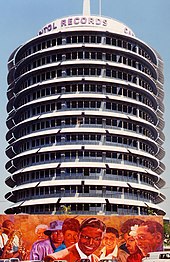
The Capitol Records Building on Vine Street, just north of Hollywood Boulevard, was built in 1956, and the Hollywood Walk of Fame was created in 1958 as a tribute to artists and other significant contributors to the entertainment industry. The official opening was on February 8, 1960.[23][24]
In 1985, the Hollywood Boulevard Commercial and Entertainment District was listed in the National Register of Historic Places.
In June 1999, the Hollywood extension of the Los Angeles County Metro Rail Red Line subway opened from Downtown Los Angeles to the San Fernando Valley, with stops along Hd Boulevard at Western Avenue, Vine Street and Highland Avenue.

The Dolby Theatre, which opened in 2001 on Hollywood Boulevard at Highland Avenue (as the Kodak Theatre), where the historic Hollywood Hotel once stood, is the home of the Oscars.
Revitalization
After years of serious decline in the 1980s, many Hollywood landmarks were threatened with demolition.[25]
Since 2000, Hollywood has been increasingly gentrified due to revitalization by private enterprise and public planners and the popularity of Hollywood's celebrity culture.[26]
Geography

According to the Mapping L.A. project of the Los Angeles Times, Hollywood is flanked by Hollywood Hills to the north, Los Feliz to the northeast, East Hollywood to the east, Larchmont and Hancock Park to the south, Fairfax to the southwest, West Hollywood to the west and Hollywood Hills West to the northwest.[27]
Street limits of the Hollywood neighborhood are: north, Hollywood Boulevard from La Brea Avenue to the east boundary of Wattles Garden Park and Franklin Avenue between Bonita and Western avenues; east, Western Avenue; south, Melrose Avenue, and west, La Brea Avenue or the West Hollywood city line.[28][29]
In 1918, H. J. Whitley commissioned architect A. S. Barnes to design Whitley Heights as a Mediterranean-style village on the hills above Hollywood Boulevard, and it became the first celebrity community.[30][31][32]
Other areas within Hollywood are Franklin Village, Little Armenia, Spaulding Square and Thai Town.[28]
Adjacent neighborhoods
Relation of Hollywood to nearby communities:[27][29]
Population
The 2000 U.S. census counted 77,818 residents in the 3.51-square-mile Hollywood neighborhood—an average of 22,193 people per square mile, the seventh-densest neighborhood in all of Los Angeles County. In 2008 the city estimated that the population had increased to 85,489. The median age for residents was 31, about the city's average.[28]
Hollywood was said to be "highly diverse" when compared to the city at large. The ethnic breakdown in 2000 was: Latino or Hispanic, 42.2%, Non-Hispanic Whites, 41%; Asian, 7.1%; blacks, 5.2%, and others, 4.5%.[28]
Mexico (21.3%) and Guatemala (13%) were the most common places of birth for the 53.8% of the residents who were born abroad, a figure that was considered high for the city as a whole.[28]
The median household income in 2008 dollars was $33,694, considered low for Los Angeles. The average household size of 2.1 people was also lower than the city norm. Renters occupied 92.4% of the housing units, and home- or apartment owners the rest.[28]
The percentages of never-married men (55.1%), never-married women (39.8%) and widows (9.6%) were among the county's highest. There were 2,640 families headed by single parents, about average for Los Angeles.[28]
In 2000, there were 2,828 military veterans, or 4.5%, a low rate for the city as a whole.[28]
These were the ten neighborhoods or cities in Los Angeles County with the highest population densities, according to the 2000 census, with the population per square mile:[33]
- Koreatown, Los Angeles, 42,611
- Westlake, Los Angeles, 38,214
- East Hollywood, Los Angeles, 31,095
- Pico-Union, Los Angeles, 25,352
- Maywood, California, 23,638
- Harvard Heights, Los Angeles, 23,473
- Hollywood, Los Angeles, 22,193
- Walnut Park, California, 22,028
- Palms, Los Angeles, 21,870
- Adams-Normandie, Los Angeles, 21,848
Radio and television


KNX was the last radio station to broadcast from Hollywood, before it left CBS Columbia Square for a studio in the Miracle Mile in 2005.
On January 22, 1947, the first commercial television station west of the Mississippi River, KTLA, began operating in Hollywood. In December of that year, The Public Prosecutor became the first network television series to be filmed in Hollywood.Television stations KTLA and KCET, both on Sunset Boulevard, are the last broadcasters (television or radio) with Hollywood addresses, but KCET has since sold its studios on Sunset and plans to move to another location. KNBC moved in 1962 from the former NBC Radio City Studios at the northeast corner of Sunset Boulevard and Vine Street to NBC Studios in Burbank. KTTV moved in 1996 from its former home at Metromedia Square on Sunset Boulevard to West Los Angeles, and KCOP left its home on La Brea Avenue to join KTTV on the Fox lot. KCBS-TV and KCAL-TV moved from their longtime home at CBS Columbia Square on Sunset Boulevard to a new facility at CBS Studio Center in Studio City.
Secession movement
In 2002, some Hollywood voters began a campaign for the district to secede from Los Angeles and become a separate municipality. In June of that year, the Los Angeles County Board of Supervisors placed secession referendums for both Hollywood and the San Fernando Valley on the ballot. To pass, they required the approval of a majority of voters in the proposed new municipality as well as a majority of voters in all of Los Angeles. In the November election, both referendums failed by wide margins in the citywide vote.[34]
Government
As a district within the Los Angeles city limits, Hollywood does not have its own municipal government. There was an official, appointed by the Hollywood Chamber of Commerce, who served as an honorary "Mayor of Hollywood" for ceremonial purposes only. Johnny Grant held this position from 1980 until his death on January 9, 2008.[35]
Police service
The Los Angeles Police Department is responsible for police services. The Hollywood police station is at 1358 N. Wilcox Ave.
Fire services
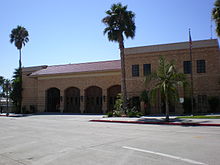
Los Angeles Fire Department operates four fire stations – Station 27, 41, 52, and 82 – in the area.
Health
The Los Angeles County Department of Health Services operates the Hollywood-Wilshire Health Center in Hollywood.[36]
Post office
The United States Postal Service operates the Hollywood Post Office,[37] the Hollywood Pavilion Post Office,[38] and the Sunset Post Office.[39]
Neighborhood councils
Hollywood is included within the Hollywood United Neighborhood Council (HUNC)[40] Hollywood Hills West Neighborhood Council[41][42] and the Hollywood Studio District Neighborhood Council.[43][44] Neighborhood Councils cast advisory votes on such issues as zoning, planning, and other community issues. The council members are voted in by stakeholders, generally defined as anyone living, working, owning property, or belonging to an organization within the boundaries of the council.[45]
Education
Hollywood residents aged 25 and older holding a four-year degree amounted to 28% of the population in 2000, about the same as in the county at large.[28]
Schools
Schools in Hollywood include:[46]

- Temple Israel of Hollywood Day School, private, 7300 Hollywood Boulevard
- Gardner Street Elementary School, LAUSD, 7450 Hawthorne Avenue
- Selma Avenue Elementary School, LAUSD, 6611 Selma Avenue
- Grant Elementary School, 1530 North Wilton Place
- Young Hollywood, private elementary, 1547 North McCadden Place
- Hollywood High School, LAUSD, 1521 North Highland Avenue[47]
- Hollywood Community Adult School, LAUSD, 1521 North Highland Avenue
- Blessed Sacrament School, private elementary, 6641 Sunset Boulevard
- Helen Bernstein High School, LAUSD, 1309 North Wilton Place
- Richard A. Alonzo Community Day School, LAUSD, 5755 Fountain Avenue
- Beverly Hills RC School, private elementary, 6550 Fountain Avenue
- Hollywood Schoolhouse, private elementary, 1233 North McCadden Place
- Joseph LeConte Middle School, LAUSD, 1316 North Bronson Avenue
- T.C.A. Arshag Dickranian School, private K-12, 1200 North Cahuenga Boulevard
- Hollywood Primary Center, LAUSD elementary, 1115 Tamarind Avenue
- Santa Monica Boulevard Community Charter School, 1022 North Van Ness Avenue
- Vine Street Elementary School, LAUSD, 955 North Vine Street
- Hubert Howe Bancroft Middle School, LAUSD, 929 North Las Palmas Avenue
- Larchmont Charter School, elementary, 815 North El Centro Avenue
- Cheder Menachem, private elementary, 1606 South La Cienega Boulevard
Public libraries
The Will and Ariel Durant Branch and the Frances Howard Goldwyn – Hollywood Regional Branch of the Los Angeles Public Library are in Hollywood.
Notable places
Within Hollywood

- CBS Columbia Square
- Charlie Chaplin Studios
- Cinerama Dome
- Crossroads of the World
- Dolby Theatre
- Earl Carroll Theatre (currently Nickelodeon on Sunset)
- El Capitan Theatre
- Frederick's of Hollywood
- Gower Gulch
- Grauman's Egyptian Theatre
- Hollywood & Western Building
- Hollywood and Highland Center
- Hollywood and Vine
- Hollywood Forever Cemetery
- Hollywood Heritage Museum
- Hollywood Palladium
- Hollywood Masonic Temple
- Hollywood Walk of Fame
- Hollywood Wax Museum
- Knickerbocker Hotel
- Madame Tussauds Hollywood
- Musso & Frank Grill
- Pantages Theatre
- Roosevelt Hotel
- Sunset Gower Studios
- TCL Chinese Theatre
Nearby
Special events

- The Academy Awards are held in late February/early March (since 2004) of each year, honoring the preceding year in film. Prior to 2004, they were held in late March/early April. Since 2002, the Oscars have been held at their new home at the Dolby (formerly Kodak) Theater at Hollywood Boulevard and Highland Avenue.
- The annual Hollywood Christmas Parade: The 2006 parade on Nov 26 was the 75th edition of the Christmas Parade. The parade goes down Hollywood Boulevard and is broadcast in the LA area on KTLA, and around the United States on Tribune-owned stations and the WGN superstation.[48]
- The Hollywood Half Marathon takes place in April (since 2012) of each year, to raise funds and awareness for local youth homeless shelters. The event includes a Half Marathon, 10K, 5K, and Kids Fun Run along Hollywood Blvd.
See also
References
- ^ "Los Angeles Herald, Volume XXXI, Number 45". By the California Digital Newspaper Collection (November 15, 1903). Retrieved Feb 22, 2014.
- ^ "Hollywood Was Once an Alcohol-Free Community". By Rachel Nuwer of smithsonianmag.com. Retrieved Feb 22, 2014.
- ^ Annual Report of the Controller of the City of Los Angeles, California. ByOffice of Controller Los Angeles, CA (1914). Retrieved Feb 22, 2014.
- ^ Report of the Auditor of the City of Los Angeles California of the Financial Affairs of the Corporation in Its Capacity as a City for the Fiscal Year. By Auditor's Office of Los Angeles, CA (1913). Retrieved Feb 22, 2014.
- ^ Margaret Leslie Davis, Rivers in the Desert (1993), p. 92.
- ^ The Father of Hollywood by Gaelyn Whitley Keith The Father of Hollywood (2010) pg. 127
- ^ The Quarterly, pg 93–94
- ^ "No. HS-7. Population of the Largest 75 Cities: 1900 to 2000" (PDF). Retrieved 2014-01-14.
- ^ "Hollywood Daily Citizen (1931)" (PDF). Retrieved 2014-01-14.
- ^ Los Angeles from the mountains to the sea: with selected biography ..., Volume 3 By John Steven McGroarty 1921 pg. 815
- ^ Cahuenga Valley Sentinel (May 7, 1904).
- ^ Hollywood Citizen (Spring Addition March 4, 1914).
- ^ Hollywood California | Hollywood History and Information. Abouthollywood.com (November 16, 2010). Retrieved on 2011-12-11.
- ^ Jacobs, Lewis; Rise of the American film, The; Harcourt Brace, New York, 1930; p. 85
- ^ Philip French (February 28, 2010). "How 100 years of Hollywood have charted the history of America". The Guardian. UK. Retrieved May 24, 2010.
- ^ RASMUSSEN, CECILIA (August 1, 1999). "L.A. Then and Now: Film Pioneer Griffith Rode History to Fame". Los Angeles Times. p. 3.
- ^ Dyson, Jonathan (March 4, 2000). "How the West was won Time lapse". The Independent. London (UK). p. 54.
- ^ Friedrich, Otto (1986). City of Nets: A Portrait of Hollywood in the 1940s. Berkeley and Los Angeles: University of California Press. p. 6. ISBN 0-520-20949-4.
- ^ "Without This Man, Hollywood May Not Exist". YouTube. 2011-01-22. Retrieved 2014-01-14.
- ^ The Father of Hollywood by Gaelyn Whitley Keith (August 31, 2010)www.thefatherofhollywood.com
- ^ Robertson (2001), p. 21. It later became the Hollywood Film Laboratory, now called the Hollywood Digital Laboratory.
- ^ "Tinseltown". Collins English Dictionary. Retrieved 2014-01-14.
- ^ History of WOF hollywoodchamber.net; Hollywood Chamber of Commerce. Retrieved May 31, 2010.
- ^ "Kramer First Name Put in Walk of Fame"(abstract). Los Angeles Times, March 29, 1960, p. 15. Full article: LA Times Archives Retrieved June 12, 2010.
- ^ By B. Russell Leavitt (1982-06-14). "Russell Leavitt, In California: A Fading Hollywood". Time.com. Retrieved 2014-01-14.
- ^ Joel Kotkin (Summer 2012). "Let L.A. be L.A." Vol. 22, no. 3. City Journal.
- ^ a b ""Central L.A.," Mapping L.A., ''Los Angeles Times''". Projects.latimes.com. Retrieved 2014-01-14.
- ^ a b c d e f g h i ""Hollywood," Mapping L.A., ''Los Angeles Times''". Projects.latimes.com. Retrieved 2014-01-14.
- ^ a b The Thomas Guide, Los Angeles County 2006, page 593
- ^ "About". Whitley Heights. Retrieved 2014-01-14.
- ^ "Whitley Heights | Office of Historic Resources, City of Los Angeles". Preservation.lacity.org. Retrieved 2014-01-14.
- ^ "About". Whitley Heights. Retrieved 2014-01-14.
- ^ "Population Density". Los Angeles Times. Mapping L.A. Retrieved June 12, 2016.
- ^ Grand, Noah (2002-11-05). "Valley, Hollywood secession measures fail". Daily Bruin. Retrieved 29 December 2013.
- ^ "Johnny Grant, honorary Hollywood mayor, dies". CNN. January 10, 2008. Retrieved January 12, 2008.
- ^ "Hollywood-Wilshire Health Center." Los Angeles County Department of Health Services. Retrieved March 18, 2010.
- ^ "Post Office Location – HOLLYWOOD." United States Postal Service. Retrieved March 18, 2010.
- ^ "Post Office Location – HOLLYWOOD PAVILION." United States Postal Service. Retrieved March 18, 2010.
- ^ "Post Office Location – SUNSET." United States Postal Service. Retrieved March 18, 2010.
- ^ "Hollywood United Neighborhood Council". Hollywoodunitednc.org. Retrieved 2014-01-14.
- ^ "WELCOME | Hollywood Hills West". Hhwnc.org. 2013-12-10. Retrieved 2014-01-14.
- ^ "Hollywood Hills West Neighborhood Council Bylaws - Area Boundaries". Hhwnc.org. 2012-02-15. Retrieved 2014-01-14.
- ^ Hollywood Studio District Neighborhood Council (2014-01-01). "Hollywood Studio District Neighborhood Council". Hsdnc.org. Retrieved 2014-01-14.
- ^ "Los Angeles Department of Neighborhood Enpowerment". Done.lacity.org. 2012-01-20. Retrieved 2014-01-14.
- ^ HSDNC.org: FAQs
- ^ "Hollywood Schools, Mapping L.A." Benny Labamba. 2012-01-20. Retrieved 2014-03-07.
- ^ School website
- ^ [1][dead link]

